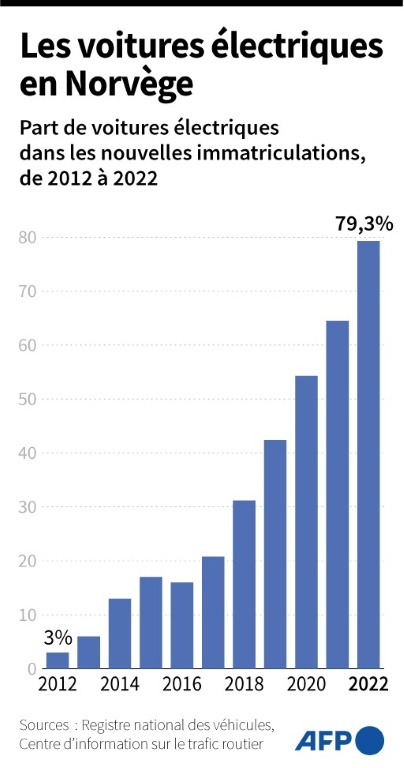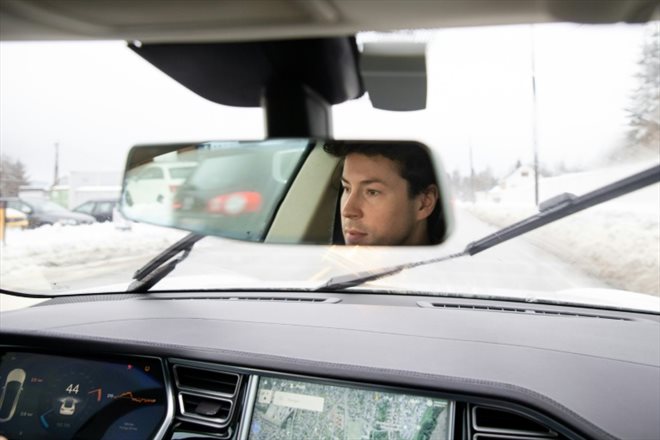Philip Benassi charges his electric Tesla on January 17, 2023 in Jessheim, Norway (AFP / Petter BERNTSEN)
The word has entered common vocabulary in Norway: “rekkevideangst”. This anxiety of the autonomy of electric vehicles, Philip Benassi knew it well at the wheel of his Tesla, especially on cold winter days, but like his compatriots, he learned to tame it.
Often freezing temperatures, rugged terrain, stretched distances… Norway is not the ideal playground for the electric car, which loses range in freezing weather.
However, the Nordic country is the undisputed world champion for the adoption of these vehicles.
Last year, a record: four out of five new cars (79%) were electric in the kingdom, a big oil producer, where the official objective is however to put an end to heat engines for new registrations from 2025. That is ten years before the European Union.
By comparison, all-electric represented 12.1% of new car sales in 2022 in the EU, compared to 9.1% a year earlier, according to statistics published on Wednesday by the European Manufacturers Association ( ACEA).
Commercial in a cosmetics group, Philip Benassi took the step towards electric in 2018. In his gleaming Tesla S, this 38-year-old Norwegian swallows between 20 and 25,000 kilometers per year.
Like most new “elbilisters” – electric car owners – he too experienced early on the anxiety of seeing the battery indicator drop rapidly.
With the specter of falling to zero, the equivalent of running out of fuel, on a deserted country road.
“I didn’t know the car well enough. But after all these years, I know roughly how many kilowatts it consumes and that it varies depending on whether it slept outside or in a garage,” he testifies.

Electric cars in Norway (AFP/Ayoub SIMOUR)
“In winter, the capacity of the batteries decreases. If the car has been left outside at temperatures between -10/-15°C, we use a lot more battery and it takes quite a while before consumption returns to normal”, he explains.
In the cold season, the loss of autonomy depends on the vehicle model and the severity of the cold snap.
“But the general rule is that a frost of about -10°C will reduce the range by about a third compared to summer weather and that a severe freeze (-20°C or more) of up to ‘half way,’ says Finnish consultant Vesa Linja-aho.
“By parking the car in a heated garage, this phenomenon can be reduced a little,” adds the expert.
– Green taxation –
When to recharge? Where? Of how many? These questions haunt first-time users. It’s all a matter of habit and planning before long journeys.

Philip Benassi driving his electric Tesla on January 17, 2023 in Jessheim, Norway (AFP / Petter BERNTSEN)
The various applications of car manufacturers and Norway’s extensive network of fast and super-fast charging points — more than 5,600 — fortunately help solve the equation.
A sign that the problem is far from insurmountable, electric cars accounted for 54% of new registrations last year in Finnmark, the northernmost region of the country. Located in the heart of the Arctic, it holds a national record that sends shivers down your spine: the mercury there fell to -51°C.
Other Nordic countries accustomed to negative temperatures, such as Iceland (33.3% of registrations in 2022) or Sweden (32.9%), are also in the world leader in all-electric cars.
“More and more electric cars have battery preheating systems, which is smart because it increases range and the car charges faster if it is heated,” said Christina Bu, secretary general of the Norwegian Association. electric vehicles.
“In fact, when it’s very, very cold, freezing temperatures, sometimes diesel cars can’t start unlike electric cars,” she notes.
The Norwegians have in any case taken the fold: more than 20% of their cars in circulation now run on clean electricity – another good point – because almost exclusively of hydraulic origin.

Christina Bu, secretary general of the Norwegian Association of Electric Vehicles, on January 23, 2023 in Oslo (AFP / Petter BERNTSEN)
Norwegian policy is proactive with highly taxed thermal engines unlike electric ones – even if the government is beginning to trim these financial advantages in order to make up for a shortfall estimated at nearly 40 billion crowns (3.8 billion euros). euros) last year.
“The recipe for success in Norway is green taxation”, sums up Christina Bu. “We tax what we don’t like, fossil fuel cars, and we encourage what we like, electric cars. It’s as simple as that,” she adds.
And “if Norway can do it, everyone can do it”.
© 2023 AFP
Did you like this article ? Share it with your friends with the buttons below.




